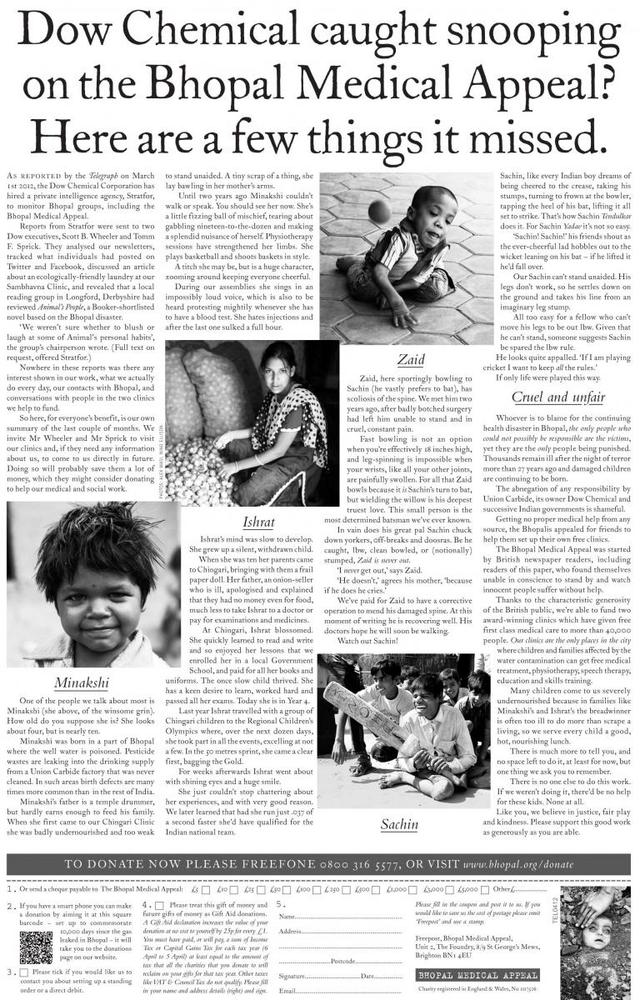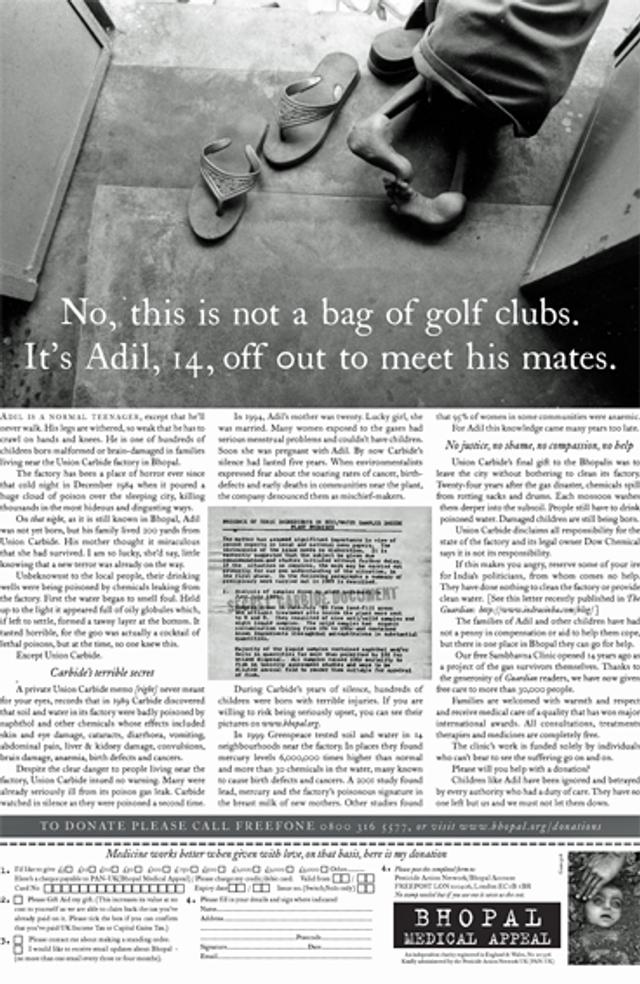Bhopal Medical Appeal: Press advertisements
- Exhibited by
- Indra Sinha
- Added
- May 22, 2014
- Medium of Communication
- Press advertising
- Target Audience
- Awareness raising, individual donors and regular givers
- Type of Charity
- Public/society benefit
- Country of Origin
- India and UK
- Date of first appearance
- 1994
SOFII’s view
Though not a fundraiser by profession, copywriter and author Indra Sinha has created some of the most effective and moving advertising campaigns of all time, not just because he’s a great writer but also because he cares passionately about the cause and he’s not afraid to let that passion show. This exhibit contains some of the finest and most effective press ads of all time. Please scroll down to see all of them.
Also, when you have read these ads, check out here to see one British charity’s response to the Bhopal tragedy, prepared in the hours following the disaster to raise funds for emergency supplies.
Summary / objectives
These eight advertisements are the latest examples of a campaign created to raise money to found and run a free clinic in Bhopal, India, for victims of the 1984 Union Carbide gas disaster. Today, over 25 years after the gas leak, more than 100,000 people are still chronically ill in the city, while tens of thousands more are drinking water poisoned by chemicals leaking from the abandoned factory.
Opened in 1996, the clinic has so far provided free medical care to around 30,000 people. Combining the best of modern medicine with traditional Indian herbal treatments and yoga, it has pioneered new drug free treatments for asthma, diabetes and menstrual problems. In 2002 the clinic won the Margaret Mead award, given to small groups who make a big difference in the world. The advertisements are crucial to the success of the clinic, which depends directly on funds raised off-the-page and on income from newsletters to donors recruited by the advertisements.
Background
The Bhopal Medical Appeal (BMA) is not just about ‘us’ asking ‘you’ to help ‘them’. To us, fundraising is about all of us together, working to oppose injustice, save lives and ease suffering. These advertisements carry the authentic voice of the Bhopal survivors, allowing us to share directly the indomitable spirit with which they have turned their suffering into struggle, charity and art. We don’t just ask, we also give something back. The Bhopal survivors are among the poorest people in the world, but they return to the rest of us a priceless gift – the knowledge, painfully gained in the living laboratories of their bodies, of how to treat industrially-caused diseases.
That night…
December 3rd, 1984. Shortly after midnight, 27 tonnes of a gas 500 times more deadly than cyanide leaked from Union Carbide’s factory in Bhopal, India. There was no warning, none of the plant's safety systems were working. In the city people were sleeping. They woke in darkness to the sound of screaming, with gas already in their eyes, noses and mouths. They began retching and coughing up froth streaked with blood. Whole neighbourhoods fled in panic, some were trampled, others convulsed and fell dead. People lost control of their bowels and bladders as they ran. Within hours thousands of dead bodies lay in the streets.
More than 25 years later, upwards of 100,000 people are still seriously ill. The drinking water of a further 20,000 has been poisoned by chemicals leaking from the abandoned plant. Ignoring ‘polluter pays’ laws, Union Carbide and its owner Dow Chemical have refused to pay for a clean up.
Special characteristics
Whole page advertisements using long copy, very detailed editorial style ads focusing on the dramatic, devastating effects of the disaster and its aftermath on the lives of real people.
Influence / impact
These ads were based on the style Indra Sinha had used very successfully some years earlier for Amnesty International UK branch.
Details
All media responses are carefully monitored and ROIs calculated.
Costs
Roughly £16,000 per round of advertising in The Guardian, The Times and The Independent with each ad running once in each publication.
Results
Return on investment (ROI) varied between 1.5:1 and 4:1 (average response has produced 150-400 per cent of media and production costs).
Merits
In breaking most of the established rules of direct response fundraising, these ads also break most records for response. Listen now to Indra Sinha, creator and writer of all of the Bhopal advertisements, as he explains why this great campaign succeeded and still continues to raise funds cost-effectively for the people of Bhopal.
Other relevant information
The Bhopal Medical Appeal began in Britain as a joint effort of ordinary individuals working with the Bhopal survivors to bring free medical relief to the victims of the gas and water disasters. It now has supporters across the world. At the Sambhavna Clinic in Bhopal all consultations, treatments, therapies and medicines are completely free. The Appeal has given medical care to around 30,000 people. The Bhopal Medical Appeal is affiliated to the International Campaign for Justice in Bhopal, which seeks to obtain legal redress for the continuing suffering of the survivors. The creator of this campaign has also written for the International Campaign for Justice in Bhopal (ICJB).
Indra is also a novelist whose latest novel, Animal’s People, set in a fictional Indian city that had suffered a Bhopal-like disaster, was short-listed for the 2007 Booker Prize.
- Bhopal Medical Appeal: B’Eau Pal publicity stunt: don’t go near the water!
- How I wrote it: the classic Amnesty press ads
- The Bhopal Medical Appeal grabs every opportunity to tell good stories
 View original image
View original image
 View original image
View original image
 View original image
View original image

 View original image
View original image























